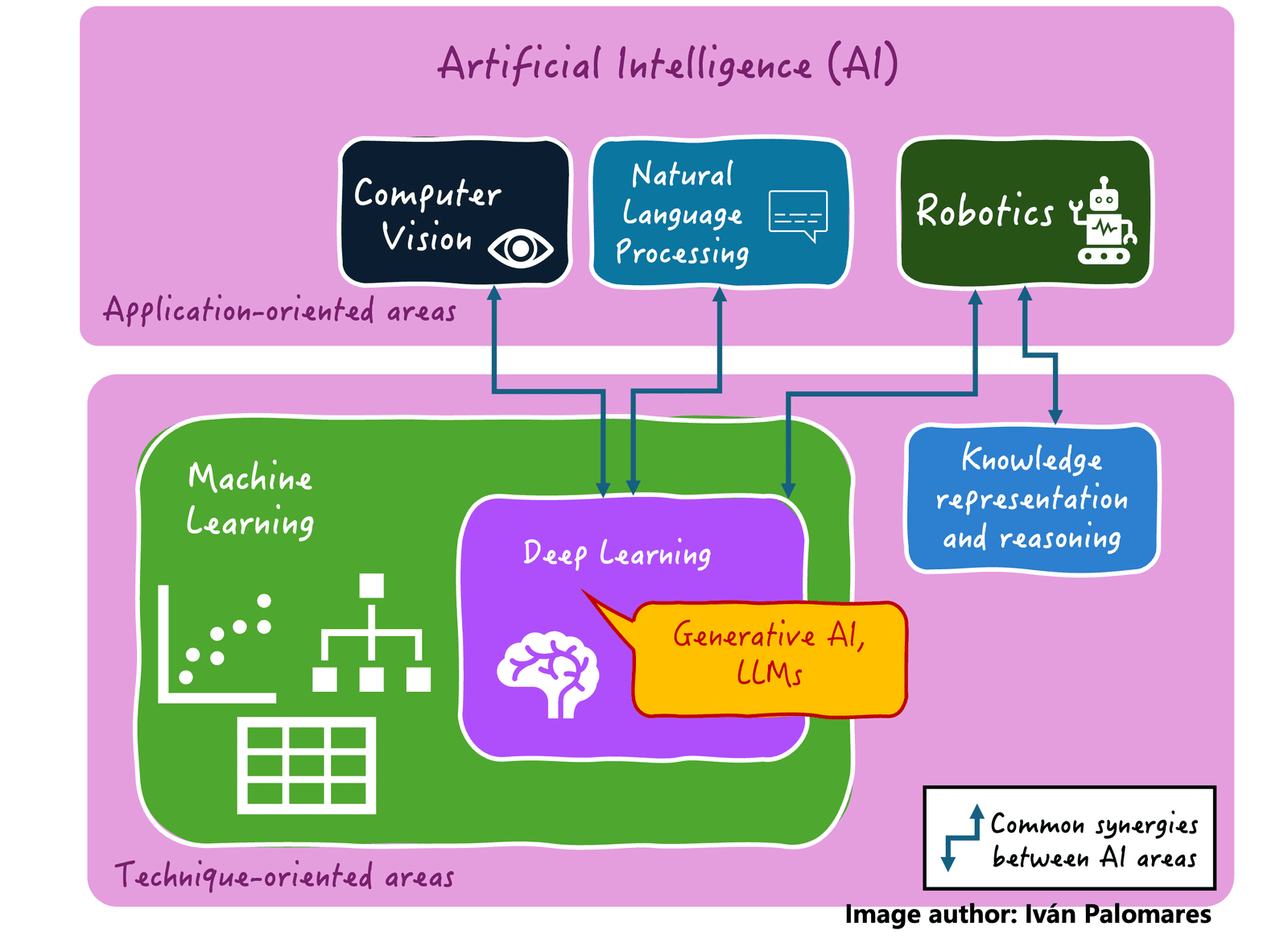Jobs & Careers
What is Artificial Intelligence in Simple Words?


Image by Editor | ChatGPT
# Introduction
Everyone talks about artificial intelligence (AI) in recent times, and chances are, depending on whom you ask, they may explain to you what AI is in a different way: often using technical, almost alien-like terms, and sometimes in simple terms. This article is intended to take the latter direction, and explain in simple words what AI is, its capabilities and limits, and some key areas or building blocks that are part of AI nowadays.
# What is AI? Capabilities and Limits
AI is a branch of computer science that focuses on the development of computer systems capable of mimicking human or animal intelligence skills to solve a particular problem or task. The intelligent traits they can emulate, depending on the specific AI system, include reasoning, predicting future or unknown facts, visual perception, communicating with humans or other AI systems, and interacting with the environment, to name a few.
One salient capability in most modern AI systems, which permeates virtually all the skills mentioned above, is the ability to learn from data. Just like a small child who learns by observing and being exposed to examples of anything (words, images, actions, etc.), AI systems learn from lots of data examples to perform complex tasks like predictions, inference, communication in human language, and much more.
Some might be surprised to hear that AI is not a 21st-century invention: in fact, the field was born in the middle of the last century. However, it is thanks to advances in learning from data — and thanks to developments in computation and data availability — that AI has experienced its biggest progress over the last decade and a half, with generative and language models like ChatGPT being clear examples of the latest, high-impact achievements.
But AI also has its limitations: it does not truly “understand” the world like humans do (everything is understood and dealt with mathematically, so to speak!), can make mistakes if it has learned from poor-quality data, and usually struggles with tasks that require common sense or human sensibilities. The vast data and computing power needed also constitute high costs.
# Areas of AI
Let’s outline the main areas of AI and some key points to gain a better understanding of them.


Areas of artificial intelligence and common symbiotic relationships between them | Image by Author
- In the early years of AI, knowledge representation and reasoning were active subjects of research, focuses on building software programs that could reason and draw conclusions upon real-world facts and knowledge represented in a machine-understandable fashion. Much of the logic between autonomous agents (sometimes implemented in robotic systems capable of interacting with the real world) relies on these techniques, and the recent rise of agentic AI solutions is reviving interest in this subdomain.
- Machine learning is by far the most widespread area of AI at present: almost every modern AI system uses approaches to learn from data to solve a task like classifying images, predicting prices or future sales, recommending products to customers, and more.
- Deep learning is like an “evolved form” of machine learning: larger and more complex systems that learn from immense datasets to address more challenging tasks. Interestingly, computer vision and natural language processing applications — like visually recognizing objects and having a conversation with a human — have recently become predominantly solved using deep learning systems, hence their close relationship.
- So, where do the latest trends of generative AI and language models (LLMs) sit? These systems are massive deep learning architectures taken to the next level.
That was a concise, gentle introduction to what AI is. Hope you enjoyed it!
Iván Palomares Carrascosa is a leader, writer, speaker, and adviser in AI, machine learning, deep learning & LLMs. He trains and guides others in harnessing AI in the real world.
Jobs & Careers
Esri India, Dhruva Space Partner to Expand Satellite Data Access

Sanjana Gupta
An information designer by training, Sanjana likes to delve into deep tech and enjoys learning about quantum, space, robotics and chips that build up our world. Outside of work, she likes to spend her time with books, especially those that explore the absurd.
Jobs & Careers
‘On-demand Tech Fuels Growth, but Rising Costs Threaten Gains for Enterprises’

On-demand technologies such as public cloud, software-as-a-service (SaaS) and generative AI are reshaping digital strategies as companies pursue innovation, agility and competitive advantage, according to a report from the Capgemini Research Institute.
However, the report highlighted that spiralling costs, fragmented management and governance gaps are eroding value, raising questions over the sustainability of returns.
The study, titled ‘The On-Demand Tech Paradox: Balancing Speed and Spend’, surveyed 1,000 executives from companies with annual revenues above $1 billion across 12 industries and 14 countries.
It found that nearly eight in 10 organisations see on-demand technologies as critical to growth, but struggle to rein in spending.
Three-quarters exceeded their public cloud budgets by an average of 10%, while 68% overspent on generative AI and 52% on SaaS, the report revealed.
Inflationary pressures, surging AI adoption and mounting digital infrastructure needs were cited as key drivers. Meanwhile, underutilised resources, decentralised procurement and unmanaged purchases, particularly in SaaS, added to the inefficiencies.
Nearly all executives admitted to bypassing IT departments for technology acquisitions, heightening costs and security risks.
While IT budgets are set to expand, with on-demand tech’s share expected to rise from 29% to 41% in the next year, the study shows that a few companies are capturing expected returns.
Only 29% realised projected SaaS savings, 33% reported improved cloud service quality, while 38% achieved faster innovation with generative AI.
Capgemini said most organisations are at an early stage of financial operations (FinOps) maturity.
Although three-quarters have or plan to establish FinOps teams, their scope remains narrow. Just 2% oversee cloud, SaaS and generative AI holistically and less than half influence business decisions.
“While on-demand technology expenses are projected to double over the next three to four years, organisations must find a way to gain transparency and control over costs while elevating value. Those that align their cloud strategy with their overall business goals are well-positioned to harness this opportunity,” Karine Brunet, CEO of Capgemini’s Cloud Infrastructure Services, said in the statement.
“By designing scalable, modular, cloud-native and frugal architecture, they are set to drive sustainable value through smarter FinOps, integrated governance, and AI-driven automation.”
Beyond financial waste, more than half of the surveyed organisations said the poor use of on-demand tech drives excess energy consumption and emissions.
Yet, only 36% have sustainability built into FinOps, despite opportunities to reduce both costs and carbon through energy-efficient architectures and workload optimisation.
The post ‘On-demand Tech Fuels Growth, but Rising Costs Threaten Gains for Enterprises’ appeared first on Analytics India Magazine.
Jobs & Careers
Drone Startup EndureAir Raises ₹25 Crore in Funding Led by IAN Alpha Fund

The funding will enhance its drone capabilities for defence applications, aid expansion into enterprise markets and further develop high-altitude logistics and aerial robotics platforms, the startup said in a press release.
Sarika Saxena, managing partner at IAN Alpha Fund, said, “EndureAir embodies the very
best of India’s deep-tech potential. By transforming cutting-edge research into powerful,
indigenous solutions, EndureAir is meeting critical needs in defence, enterprise and disaster
response.”
Founded in 2018 by Abhishek, a professor at IIT Kanpur, with his former students Rama Krishna and Ch
-

 Business2 weeks ago
Business2 weeks agoThe Guardian view on Trump and the Fed: independence is no substitute for accountability | Editorial
-
Tools & Platforms4 weeks ago
Building Trust in Military AI Starts with Opening the Black Box – War on the Rocks
-

 Ethics & Policy1 month ago
Ethics & Policy1 month agoSDAIA Supports Saudi Arabia’s Leadership in Shaping Global AI Ethics, Policy, and Research – وكالة الأنباء السعودية
-

 Events & Conferences4 months ago
Events & Conferences4 months agoJourney to 1000 models: Scaling Instagram’s recommendation system
-

 Jobs & Careers2 months ago
Jobs & Careers2 months agoMumbai-based Perplexity Alternative Has 60k+ Users Without Funding
-

 Podcasts & Talks2 months ago
Podcasts & Talks2 months agoHappy 4th of July! 🎆 Made with Veo 3 in Gemini
-

 Education2 months ago
Education2 months agoMacron says UK and France have duty to tackle illegal migration ‘with humanity, solidarity and firmness’ – UK politics live | Politics
-

 Education2 months ago
Education2 months agoVEX Robotics launches AI-powered classroom robotics system
-

 Funding & Business2 months ago
Funding & Business2 months agoKayak and Expedia race to build AI travel agents that turn social posts into itineraries
-

 Podcasts & Talks2 months ago
Podcasts & Talks2 months agoOpenAI 🤝 @teamganassi

